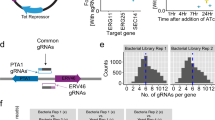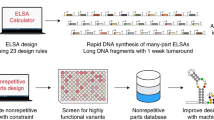Abstract
Converting the complete genome sequence of Candida albicans into meaningful biological information will require comprehensive screens for identifying functional classes of genes. Most systems described so far are not applicable to C. albicans because of its difficulty with mating, its diploid nature, and the lack of functional random insertional mutagenesis methods. We examined artificial gene suppression as a means to identify gene products critical for growth of this pathogen; these represent new antifungal drug targets. To achieve gene suppression we combined antisense RNA inhibition and promoter interference. After cloning antisense complementary DNA (cDNA) fragments under control of an inducible GAL1 promoter, we transferred the resulting libraries to C. albicans. Over 2,000 transformant colonies were screened for a promoter-induced diminished-growth phenotype. After recovery of the plasmids, sequence determination of their inserts revealed the messenger RNA (mRNA) they inhibited or the gene they disrupted. Eighty-six genes critical for growth were identified, 45 with unknown function. When used in high-throughput screening for antifungals, the crippled C. albicans strains generated in this study showed enhanced sensitivity to specific drugs.
This is a preview of subscription content, access via your institution
Access options
Subscribe to this journal
Receive 12 print issues and online access
$209.00 per year
only $17.42 per issue
Buy this article
- Purchase on Springer Link
- Instant access to full article PDF
Prices may be subject to local taxes which are calculated during checkout





Similar content being viewed by others
References
Fox, J.L. Fungal infection rates are increasing. ASM News 10, 515–518 (1993).
Fisher Hoch, S.P. & Hutwagner, L. Opportunistic candidiasis: an epidemic of the 1980s. Clin. Infect. Dis. 21, 897–904 (1995).
Groll, A.H., Piscitelli, S.C. & Walsh, T.J. Clinical pharmacology of systemic antifungal agents: a comprehensive review of agents in clinical use, current investigational compounds, and putative targets for antifungal drug development. Adv. Pharmacol. 44, 343–501 (1998).
Jack, D.B. The search for new antifungal drugs and strategies continues. Drug News Perspect. 11, 306–309 (1998).
Smith, V., Botstein, D. & Brown, P.O. Genetic footprinting: a genomic strategy for determining a gene's function given its sequence. Proc. Natl. Acad. Sci. USA 92, 6479–6483 (1995).
Fairhead, C., Thierry, A., Denis, F., Eck, M. & Dujon, B. “Mass-murder” of ORFs from three regions of chromosome XI from S. cerevisiae. Gene 223, 33–46 (1998).
Magee, B.B. & Magee, P.T. Induction of mating in Candida albicans by construction of MTLa and MTLα Strains. Science 14, 310–313 (2000).
Hull, C.M., Raisner, R.M. & Johnson, A.D. Evidence for mating of the “asexual” yeast Candida albicans in a mammalian host. Science 14, 307–310 (2000).
Matthews, G.D., Goodwin, T.J., Butler, M.I., Berryman, T.A. & Poulter, R.T. pCal, a highly unusual Ty1/copia retrotransposon from the pathogenic yeast Candida albicans. J. Bacteriol. 179, 7118–7128 (1997).
Pla, J., Gil, C., Monteoliva, F., Sanchez, M. & Nombela, C. Understanding Candida albicans at the molecular level. Yeast 12, 1677–1702 (1996).
Fonzi, W.A. & Irwin, M.Y. Isogenic strain construction and gene mapping in Candida albicans. Genetics 134, 717–728 (1993).
Wilson, R.B., Davis, D. & Mitchell, A.P. Rapid hypothesis testing with Candida albicans through gene disruption with short homology regions. J. Bacteriol. 181, 1868–1874 (1999).
de Hoogt, R., Contreras, R., Luyten, W.H.M.L. & De Backer, M.D. PCR- and ligation-mediated synthesis of split-marker cassettes with long flanking homology regions for gene disruption in Candida albicans. BioTechniques 28, 1112–1116 (2000).
De Backer, M.D., Pla J. & Magee P. Recent developments in molecular genetics of Candida albicans [review]. Annu. Rev. Microbiol. 54, 463–498 (2000).
Del Rosario, M., Stephans, J.C., Zakel, J., Escobedo, J. & Giese, K. Positive selection system to screen for inhibitors of human immunodeficiency virus-1 transcription. Nat. Biotechnol. 14, 1592–1596 (1996).
Atkins, D., Arndt, G.M. & Izant, J.G. . Antisense gene expression in yeast. Biol. Chem. Hoppe-Seyler 375, 721–729 (1994).
Atkins, D. & Gerlach, W.L. Artificial ribozyme and antisense gene expression in S. cerevisiae. Antisense Res. Dev. 4, 109–117 (1994).
Giese, K. Method and construct for screening for inhibitors of transcriptional activation. International patent application WO 97/10360 (1997).
De Backer, M.D. et al. Transformation of Candida albicans by electroporation. Yeast 15, 1609–1618 (1999).
Ferbeyre, G., Bratty, J., Chen, H. & Cedergren, R. . Cell cycle arrest promotes trans-hammerhead ribozyme action in yeast. J. Biol. Chem. 271, 19318–19323 (1996).
Nelissen, B., Mordant, P., Jonniaux, J-L., De Wachter, R. & Goffeau, A. Phylogenetic classification of the major superfamily of membrane transport facilitators, as deduced from yeast genome sequencing. FEBS Lett. 377, 232–236 (1996).
Fraser, C.M. et al. The minimal gene complement of Mycoplasma genitalium. Science 270, 397–403 (1995).
Fleischmann, R.D. et al. Whole-genome random sequencing and assembly of Haemophilus influenzae. Science 269, 496–512 (1995).
Sinclair, D.A. & Guarente, L. Extrachromosomal rDNA circles—a cause of aging in yeast. Cell 91, 1033–1042 (1997).
Reeder, R.H. & Lang, W.H. Terminating transcription in eukaryotes: lessons learned from RNA polymerase I. Trends Biochem. Sci. 22, 473–477 (1997).
Moehle, C.M. Patent application RiboGene Inc., PCT WO 95/11969 (1995).
Numata, K., Yamamoto, H., Hatori, M., Miyaki, T. & Kawaguchi, H. Isolation of an aminoglycoside hypersensitive mutant and its application in screening. J. Antibiot. 39, 994–1000 (1986).
Oliver, S. Redundancy reveals drugs in action. Nat. Genet. 21, 245–246 (1999).
Jensen-Pergakes, K.L. et al. Sequencing, disruption, and characterization of the Candida albicans sterol methyltransferase (ERG6) gene: drug susceptibility studies in erg6 mutants. Antimicrob. Agents. Chemother. 42, 1160–1167 (1998).
De Backer, M.D. et al. Single allele knockout of C. albicans CGT1 leads to unexpected resistance to hygromycin B and elevated temperature. Microbiology 146, 353–365 (2000).
Blin, N. & Stafford, D.W. A general method for isolation of high molecular weight DNA from eukaryotes. Nucleic Acids Res. 3, 2303–2308 (1976).
Zhu, J., Kempenaers, W., Van der Straeten, D., Contreras, R. & Fiers, W. A method for fast and pure DNA elution from agarose gels by centrifugal filtration. Bio/Technology 3, 1014–1016 (1985).
Leuker, C.E., Sonneborn, A., Delbruck, S. & Ernst, J.F. Sequence and promoter regulation of the PCK1 gene encoding phosphoenolpyruvate carboxykinase of the fungal pathogen Candida albicans. Gene 192, 235–240 (1997).
Orlando, C., Pinzani, P. & Pazzagli, M. Developments in quantitative PCR. Clin. Chem. Lab. Med. 36, 255–269 (1998).
Lie, Y.S. & Petropoulos, C.J. Advances in quantitative PCR technology, 5′ nuclease assays. Curr. Opin. Biotechnol. 9, 43–48 (1998).
Sambrook, J., Fritsch, E.F. & Maniatis, T. Molecular cloning: a laboratory manual, Edn. 2. (Cold Spring Harbor Laboratory, Cold Spring Harbor, NY; 1989).
De Backer, M.D. et al. Genomic cloning, heterologous expression and pharmacological characterization of a human histamine H1 receptor. Biochem. Biophys. Res. Commun. 197, 1601–1608 (1993).
Acknowledgements
We thank Dr. J. Vialard, Dr. G. Froyen, Dr. T. Ilyina, H. Vanden Bossche, T. Thielemans, Dr. R. Gordon, N. Delcroix, S. De Breucker, K. De Wagter, A. Diels, M. Hijzen, G. Verheyen, and I. Van de Weyer (all at Janssen Pharmaceutica Beerse) for much appreciated contributions. We are grateful to J. Kaufman (R.W. Johnson Pharmaceutical Research Institute, San Diego, CA) for graphical support. This work was supported in Belgium by the IWT (grant 960192) and VIB.
Author information
Authors and Affiliations
Corresponding author
Rights and permissions
About this article
Cite this article
De Backer, M., Nelissen, B., Logghe, M. et al. An antisense-based functional genomics approach for identification of genes critical for growth of Candida albicans. Nat Biotechnol 19, 235–241 (2001). https://doi.org/10.1038/85677
Received:
Accepted:
Issue Date:
DOI: https://doi.org/10.1038/85677
This article is cited by
-
Chemogenomic profiling of Plasmodium falciparum as a tool to aid antimalarial drug discovery
Scientific Reports (2015)
-
Reconstitution of the peptidoglycan cytoplasmic precursor biosynthetic pathway in cell-free system and rapid screening of antisense oligonucleotides for Mur enzymes
Applied Microbiology and Biotechnology (2014)
-
Candida albicans ENO1 null mutants exhibit altered drug susceptibility, hyphal formation, and virulence
Journal of Microbiology (2013)
-
RNA-Mediated Gene Silencing in Candida albicans: Inhibition of Hyphae Formation by Use of RNAi Technology
Mycopathologia (2012)
-
RNAi as a potential tool for biotechnological applications in fungi
Applied Microbiology and Biotechnology (2011)



